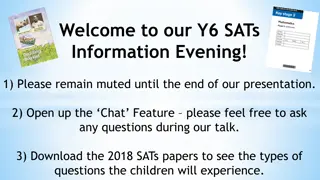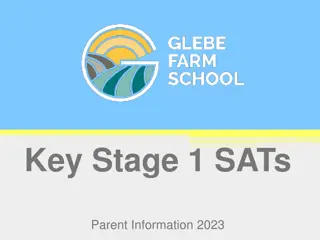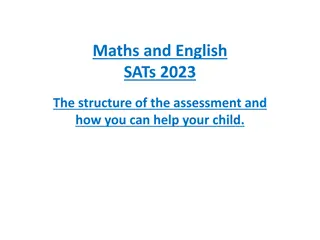Understanding the Year 6 SATs at St. Nicholas CE Primary Academy
Explore the important details about the Year 6 SATs meeting at St. Nicholas CE Primary Academy, including the aims of the meeting, what SATs stand for, details about KS2 SATs, how assessments are recorded, and how SATs week is organized. Discover insights on how parents can support their child at home and what to expect during this significant assessment period. Get ready for the SATs week commencing Monday, 11th May.
Download Presentation

Please find below an Image/Link to download the presentation.
The content on the website is provided AS IS for your information and personal use only. It may not be sold, licensed, or shared on other websites without obtaining consent from the author. Download presentation by click this link. If you encounter any issues during the download, it is possible that the publisher has removed the file from their server.
E N D
Presentation Transcript
St. Nicholas CE Primary Academy Friday 31st January 2020 Welcome to the Year 6 SATs meeting
Aims of the meeting To share important information about KS2 SATs To answer questions about KS2 SATs To discuss and share ideas about how you, as a parent, can help your child at home.
What does SATs stand for? Statutory Assessment Tasks and Tests (also includes Teacher Assessment). SATs are taken at the end of Key Stage 1 (at age 7) and at the end of Key Stage 2 (at age 11).
What are KS2 SATs? KS2 SAT tests are taken by pupils in year 6 (when they are 10-11 years old) as part of the National Curriculum assessment programme. KS2 SAT results can be used by secondary schools to put pupils into suitable sets for core subjects. They will also use these results to predict their GCSE grades. Year 6 pupils undertake KS2 SAT papers in two core subjects: English and Maths. The school may be selected to undertake a Science Sample Test.
How is the assessment recorded? Pupils will have to be working at expected standards and pupils will have to gain a score of 100 to be deemed as working at this expected standard. Pupils who score between 80 and 99 will be assessed as working towards the standard. Historically, students whose scores were in the range above 110 were deemed to be working at a higher level within the expected standard.
The papers are marked externally and the results are sent back to the school with the provisional identification of: - Working at the expected level - Not working at the expected level These results should be returned early July. If we, as a school, feel there are issues we can appeal results.
How is SATs week organised? A timetable is issued to schools, informing us on which days/sessions, tests must be administered. All pupils must sit the tests at the same time. Test papers can only be opened 1 hour before the tests begin. Tests are completed in classrooms - displays that may help pupils are covered. Pupils are divided into groups for test administration to ensure they are properly supported and feel secure.
SATs Timetable SATs will take place during the week commencing Monday 11th May to Thursday 14th May 2020.
SATs Timetable Monday 11th May - English grammar, punctuation and spelling Paper 1 short answer - English grammar, punctuation and spelling Paper 2 - spelling Tuesday 12th May - English reading Wednesday 13th May - Mathematics Paper 1 - arithmetic - Mathematics Paper 2 - reasoning Thursday 14th May - Mathematics Paper 3 - reasoning
English SATs English SATs consist of: A reading test A grammar, punctuation and spelling test
English Comprehension English Comprehension The reading comprehension is a challenging paper. Pupils will have a total of one hour to read the texts and complete the questions at their own pace pacing is a skill we will be working on in school. Reading Plus will help. The questions target different reading skills. These include: find and retrieve, inference, summarising, predicting, comparing, explaining the meaning of words in context.
Example of KS2 reading questions Vocabulary formed a LARGE part of last previous papers. The knowledge of the vocabulary and the ability to gain meaning of unknown words from the context was tested thoroughly.
English, grammar, punctuation & spelling The test will assess grammar, punctuation, spelling & vocabulary.
How can parents help with reading? Reading Plus. Ensure your child reads every night. Encourage them to read fiction and non-fiction. Try to listen to your child read and ask them questions about the text. Help them with the different skills of reading especially skim reading where they are looking for key words in the text. Test knowledge of vocabulary what does that word mean? Booster/ Revision sessions.
Assessment of writing Assessment of writing There is no longer a written assessment test. Pupils work is assessed across the year and teaching is targeted towards the improvement of the pupil s individual writing. Internal and inter-school moderation occurs and Local Authority moderators visit schools to ensure high standards of teacher assessment.
Mathematics Mathematics Mathematics SATs consist of: Three Maths Papers Paper 1 Arithmetic Paper. Paper 2 and Paper 3 Reasoning Papers. Calculators are not permitted in any of the Maths tests. Calculators are not permitted in any of the Maths tests.
Paper 1: Paper 1: It is an arithmetic paper. Questions will be context free. They will assess number, calculations and fractions. The fractions strand in the new national curriculum covers fractions, decimals and percentages. Pupils will be expected to use formal methods to solve specific arithmetic questions, e.g. long multiplication and long division. There will be guidance in the test booklet to indicate when a formal method is required. Two marks will be available for these questions. One mark may be awarded if an appropriate formal method is used but the final answer is incorrect. Each question in the arithmetic paper will have a grid area to encourage appropriate working out. Timings for the test: Timings for the test: Paper 1: 30 minutes to answer approximately 36 questions Paper 1: 30 minutes to answer approximately 36 questions
Paper 2 and Paper 3: Paper 2 and Paper 3: Assesses pupils ability to apply mathematics to problems and to reason. There won t be significant differences in format or difficulty between the two papers. The tests will contain a mixture of contextualised and context-free questions, and real life and abstract problems. Timings for the test Paper 2 and Paper 3: Timings for the test Paper 2 and Paper 3: Each paper will take 40 minutes. Each paper will take 40 minutes.
How can parents help with Maths? TIMES TABLES! TIMES TABLES! Times table Rock Stars Help your child to check their work through this will help them to spot mistakes that can sometimes be easily fixed. Get your child to verbally explain how they will solve/have solved the problem. Explaining reasoning is key to developing the skill of choosing appropriate problem- solving methods. Booster/ Revision sessions.
Thank you for coming. Thank you for coming. Any questions? Any questions?























